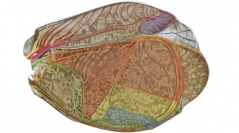

 Zoosystema
45 (24) - Pages 769-801
Zoosystema
45 (24) - Pages 769-801The Ensifera are famous for the diversity of their acoustic devices and have been intensively studied for their acoustic behaviour and evolution. They sing mostly by scrapping their forewings against each other. Their apparatus includes a stridulatory file and several broad areas that may play as sound resonators, which homology has been harshly debated. Most previous studies focussed on the functional parts, while the whole forewing venation has been less studied in a comparative context. Here, we extend recent observations with 3D-microtomography to study the venation of the forewing of both modern and fossil Ensifera, focussing more specifically on true crickets (Grylloidea Laicharting, 1781), mole crickets (Gryllotalpidae Leach, 1815) and their fossil allies (†Baissogryllidae Gorochov, 1985, †Protogryllidae Zeuner, 1937). We propose a complete pattern of forewing venation for the Gryllidea Laicharting, 1781, extending the paradigm proposed by Béthoux & Nel (2001, 2002) for fossils. This pattern defines the acoustic and non-acoustic structures using well-defined homologies through the whole Gryllidea. We put in evidence potential apomorphies for Gryllidea, Grylloidea and Gryllotalpidae, but none of the wing traits originally proposed to define the †Baissogryllidae or the †Protogryllidae are found exclusively in these taxa. Our observations support the hypothesis of convergence between crickets and mole crickets for the stridulatory file.
wing morphology, homology, evolution, acoustic communication